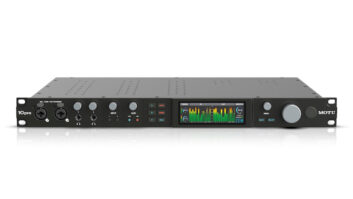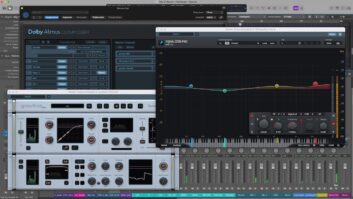
With native-based DAWs coming into their own as they ride atop multi-core mega-machines, today’s audio enthusiasts are turning their attention — and dollars — to a marketplace full of affordable and quick FireWire interfaces. With fierce competition and plenty of 8-channel interfaces for users to choose from, MOTU’s 8pre puts an enticing spin on things with its ability to double-up as a stand-alone A/D converter and a 16×12 FireWire interface capable of 24-bit/96kHz audio.
FACE VALUE
The 8pre’s 1U chassis includes independent controls for all eight analog inputs, including input potentiometers with up to 40 dBs of gain, each accompanied by a -20dB pad and a 48V switch. Metering is via eight five-segment LEDs, with a range of -42 to -1 dBFS. A rotary encoder multitasks as a volume control for the front panel ¼-inch headphone jack or the main ¼-inch TRS outputs on the rear.
Rear panel connections come on eight analog XLR/TRS mic/instrument connectors, while two ¼-inch TRS +4dB balanced analog outs provide a feed for amplifiers or active monitors. Digital outs are on four ADAT optical Lightpipe jacks that support sample rates ranging from 44.1 kHz to 96 kHz (SMUX). It also has a proprietary “Type-2” protocol to connect optically to other MOTU interfaces. IDI I/O and two FireWire ports allow the 8pre to daisy-chain up to four MOTU FireWire interfaces.
APPS OF STEEL
The 8pre is compatible with Mac OS X (Intel) and also supports late-model G4 and G5 PowerPC Macs, as well as Windows XP and Vista. For this review, I interfaced the 8pre with a PCAudioLabs machine running Windows XP Pro powered by two dual-core 2.41GHz AMD Opteron Processor 280s and fortified with 3 GB of RAM.
Setup was easy with MOTU’s Universal Audio Installer, which includes WDM/ASIO/Core Audio drivers and a few apps, including the MOTU Audio Setup, which allows you to manage a single or multiple MOTU units, along with control parameters that designate which unit is the clock master, buffer setting, sample rate, etc. The CueMix Console app controls the onboard, DSP-driven hardware mixer for tracking sessions without latency or CPU overhead, also allowing for different monitor mixes for the main outs or the headphone outs. For sync purposes, the MOTU SMPTE Setup allows the 8pre to generate, regenerate and read any frame rate via any of its analog I/Os with any DAW that supports the ASIO-2 sample-accurate sync protocol.
CHECK IT OUT
The 8pre was used in stand-alone converter mode feeding a Pro Tools HD2 system at 24-bit/44.1kHz. I connected the 8pre to a Digidesign 96 I/O with a Lightpipe cable and resolved Pro Tools to clock off the 8pre. I used the 8pre to capture a drum kit that I previously recorded with my MOTU 828mkII but have always been limited to its two preamps. On a 24-inch kick miked with a Shure Beta 52, the results were identical to those received with a 828mkII: full-bodied with well-defined lows and good attack. On snare, an Audio-Technica ATM23HE yielded a nice balance of stick attack and snare depth. For overheads, I used the Neumann U87Ai in a spaced pair. The setup reflected good stick detail on the cymbals and a balanced tom sound. The mids were a bit uninspiring, most noticeably with the snare, but this was easily fixed by bringing local mics into the mix.
At high sample rates of 96 kHz, the high-end detail was good, especially for the price ($595), but it lacked that open, airy quality found on much more expensive converters. However, compared to my Digi 002 Rack, I prefer the MOTU’s converters hands-down. The shining combination was a BLUE Woodpecker and the 8pre. At three feet above the kit and dead-center, the kit sounded well-balanced and full.
To audition the instrument DI inputs, I used a Fender Jazz bass with active pickups and compared the 8pre’s preamps to a PreSonus MP20. I used the 8pre in Interface mode and recorded two takes: Take one was the bass patched directly into the 8pre as a DI, and take two was the MP20 functioning as the DI and patching the output of the MP20 into one of the 8pre’s line inputs. The results were almost indiscernible. Both had great lows with a full, robust sound. The MP20 just edged out the 8pre with slightly better mids. Again, the MP20’s two preamps cost as much as the 8pre.
8(PRE) IS ENOUGH
The 8pre was a breeze to set up and sounded good in a variety of uses. If you have an 828mkII or a Traveler, then you’re already familiar with the sound: good highs and lows with satisfactory mids. The ADAT Lightpipe connections are a great addition for expanding other interfaces with eight more inputs. The addition of a S/PDIF and word clock connection would be nice, but that might affect the attractively low price.
Even with all the competition in this price range, the 8pre sets an example by being able to work as a stand-alone converter. The PreSonus Firepod and Focusrite Saffire Pro 10 I/O both have eight dedicated preamps but no Lightpipe connectivity or front panel metering. As a stand-alone converter and a FireWire interface with eight good-sounding mic preamps and SMPTE sync to boot, the 8pre is a strong addition to the MOTU roster.
MOTU, 617/576-2760, www.motu.com.
Phoenix-based Tony Nunes is an audio engineer.







